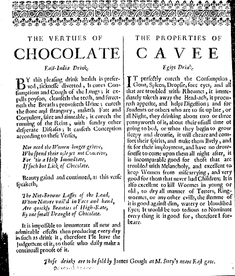 Anon. 1660 Wing / 1961:07 Anon. 1660 Wing / 1961:07 As I'm finishing up my third historical mystery--The Masque of a Murderer--I found that I still had a few more things to research. In particular, what would commoners living in 17th-century London have known of chocolate, and how might they have experienced it for the first time? References to "chocolate" in England can first be found in the 1640s. Of course, "chocolate" as a substance had been around for several thousand years as Smithonian.com explains, originating in Mesoamerica. However, it did not find its way to Europe until the early seventeenth century, as one of the strange products imported from the New World. The word "chocolate" comes from the Aztec word "xocoatl," (or is it the Nahuatl word chocolatl?) referring to a bitter drink derived from cacao beans, with medical and health properties (for more about the etymology of the word, check out Oxford Dictionaries blog for ten facts concerning the word Chocolate... ). By the 1650s, several discourses on the "physicks" and health properties of chocolate were in circulation in London. In 1640, "A Curious Treatise of the nature and quality of Chocolate" by Antonio Colmenero, a Spanish"Doctor in Physicke and Chirurgery, was translated into English. More significantly, Henry Stubb published the far more substantial treatise on "The Indian Nectar" in 1662. We know too, from a collection of 1667 statutes from King Charles II that there were restrictions on who could sell chocolate: "And be it further Enacted by Authority aforesaid, That from and after the said first day of September, no person or persons shall be permitted to sell or retail any Coffée, Chocolate, Sherbet or Tea, without License first obtained and had by Order of the General Sessions of the Peace in the several and respective Counties,etc etc." This makes me reasonably certain that chocolate would have been sold at coffee houses, for those would have been the establishments likely to acquire such a license. It is unlikely that chocolate would have been sold at taverns or alehouses, at least in early Restoration England, due to the great dispute between those who sold wine and beer, and those who sold coffee. Chocolate might have been procured for medicinal purposes as well, although it is unclear to me--at least at this preliminary stage--whether it would have been actively prescribed by a physician. However, if the "Virtues" are to be believed (of course, that's if they are to believed), chocolate cures infertility, "ill complexion," digestive illnesses, consumption and "coughs to the lungs," "sweetens the breath," "cleaneth the teeth," "provoketh urine" and "cureth the stone." Apparently, this miracle drug also cures "the running of the reins," (the last a euphemistic biblical reference to venereal disease). Who knew? I have to surmise a bit here, on how popular chocolate truly was in Restoration London. But I think it's reasonable to assume, especially once sugar became a more common household good, that it would have been become popular fairly quickly. (Although it's also likely that it remained in the realm of the elite and wealthy, for quite some time.) But what do you think? England and Wales. A collection of the statutes made in the reigns of King Charles the I. and King Charles the II. with the abridgment of such as stand repealed or expired. Continued after the method of Mr. Pulton. With notes of references, one to the other, as they now stand altered, enlarged or explained. To which also are added, the titles of all the statutes and private acts of Parliament passed by their said Majesties, untill this present year, MDCLXVII. With a table directing to the principal matters of the said statutes. By Tho: Manby of Lincolns-Inn, Esq. 1667 Wing (CD-ROM, 1996) / E898
Wing / 2532:08
2 Comments
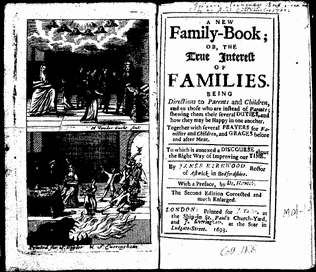 In seventeenth-century England, the role of servants was far more nuanced and flexible than readers today may realize. Certainly, there was a long-standing patriarchal expectation that the head of a family would maintain a godly and dutiful order over his household. In advice manuals, published letters and sermons, men were repeatedly admonished on how to treat the servants living in their homes. Men were expected to provide food, shelter, religious instruction, and a disciplined hand, much as they were expected to treat their own children and wives. They were not supposed to treat their servants as slaves; indeed, quite the opposite. However, we must always consider the tensions between prescription and practice. Just because the expectations were stated, most certainly does not mean that the expectations were met. For example, in Advice of a father, or, Counsel to a child (1664), men were admonished to:
For this reason, as the last injunction suggests, discretion was particularly important (perhaps because it was not always be realized). The Early English Books are full of tales of servants blackmailing their employers, because they had discovered something the master (or mistress!) would rather have kept hidden (e.g. adultery, gambling debts, infanticide etc). Thus, the same advice manual warns:
This last point suggests that even the lowest servant in his employ should be treated as all the other servants were treated.While the master was expected to rule with a firm hand, he was more like a benevolent monarch than a tyrant:
There's a pragmatic realization here that seems to transcend the ages. If you work someone without letting them "blow off steam," then you run the risk of having unmotivated, even hostile or violent, servants in your household. This holds with the reality of homicide trends in the 17th century: Far more servants killed their masters, than masters killed their servants! This injunction also fits in with the many accounts across the Early English books of servants getting some days off, attending the theatres and fairs, going to market, visiting family, even sharing in merriments with the family. While the author of this piece would mostly likely call for moderation, it's clear that masters did give their servants more freedoms than might be assumed. 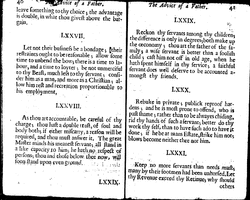 Anon. (1664). Advice of a father Anon. (1664). Advice of a father I want to point out one other piece of advice offered in this manual: "Reckon thy servants among thy children; the difference is only in degrees; both make up the economy; thou art the father of the family; a wife servant is better than a foolish child; cast him not off in an old age, when he has spent himself in thy service; a faithful servant does well deserve to be counted among thy friends." There was, without a doubt, a recognition that loyal servants could become more like members of the family over time. In this particular injunction, the master is told not to throw out his servants just because they have become old, but rather to take care of them. The best example I can think of, to help illustrate how a servant could become like a family member over time, is to draw on a 1960s reference: Would the Brady Bunch have thrown out Alice? In my recent novel, A Murder at Rosamund's Gate, I touch on a lot of these issues. I deliberately placed my protagonist Lucy Campion, in the household of a magistrate, at a time when Enlightened principles were starting to emerge in England. In my story, I deliberately juxtapose the reasoned household of the magistrate, with the less disciplined households that surrounded them. I wanted my magistrate then to be a more Enlightened thinker, more concerned with ideas, than the person who suggested those ideas to him. So he could have listened to and believed in the views of a servant with an intelligent lively mind. Perhaps I gave Lucy too many freedoms, perhaps I didn't. Ultimately, I do not think there is any blanket, all-encompassing way to look at the relationship between masters and servants in 17th century England. Arguably, these attitudes may have changed in the 18th and 19th century (although I doubt there was a monolithic understanding of this relationship even then), but the bottom line is this: The relationship between master and servant in the 17th century was far more nuanced and flexible than is often assumed. This is my story, and I'm sticking to it! 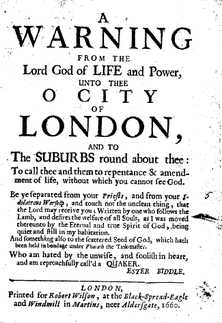 Esther Biddle, Quaker, 1660 This weekend I had the fun of seeing my first guest blog "Prophecy and Polemic— The Earliest Quaker Women" posted on the English Historical Fiction Authors website. There, I discuss why Quaker women were so political and how they differed in one particular way from most other women at the time--even members of other non-conformist sects (such as the Diggers, the Ranters, the Levelers etc). And oh! how they expressed themselves... Dressing in sack-cloth "Running naked as a sign" Refusing to bow to authority But that wasn't all... Quaker women were different because they wrote. And they wrote. And they wrote. And they wrote. In fact, as a group, Quaker women wrote 220 tracts before 1700, more than any other women. Petitions, broad-sides, chapbooks--all carrying admonitions to King, Parliament and clergy to recognize sinful acts, accounts of injustices and cruelties to their members, and pleas to release their religious brethren from prisons and authorize non-conformist worship in England, and the American colonies. I've always respected the bravery and creativity shown by the earliest Quakers, in their attempt to get their message heard. I've often thought how hard that must have been for them to write these open pieces. They were not just challenging Parliament, Magistrates, Churchmen and the King: they were challenging convention and the very heart of patriarchy, often risking public ridicule, shaming, abuses and imprisonment. Taking the mantles of Old Testament prophets, mid-seventeenth century Quaker women wrote openly about the social wrongs they perceived around them, especially those caused by the (imagined and real) abuses of men in power. In the soul-examining spirit of the time, Quaker women--like their male counterparts--also wrote publicly about their own struggles to find the "Inner Light" and to give up earthly fripperies. (Poor Susannah Whitrowe--she really wanted to cling to her ribbons, but knew she wasn't supposed to) They wrote about death and heartbreak, joy and promise. (This is not too suggest that they did not use their expressions of suffering to advance their cause--both politically and religiously--but there is an honesty to their expression that is admirable). At a time when women who wrote were disparaged as "petticoat authors," early Quaker women persevered to make their voices known. Just as they "ran naked as a sign" to convey their discontent to religious and secular authorities, they wrote nakedly too. They laid their emotions and concerns bare, for public consumption, expressing themselves in ways that were both daunting and inspiring. As I writer, I certainly struggle to lay my words bare on the page. Those little editorial voices are hard to muffle! I'm hoping, with time, to find my most authentic voice. How about you? 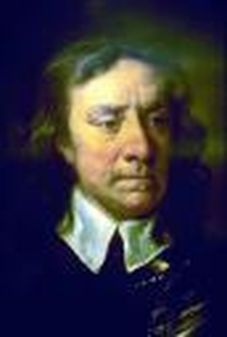 Oliver Cromwell, destroyer of mince pies _I can't say I've ever had mince pie, but I never would have guessed it has such a secretive, mysterious history. Is the mince pie capable of being so subversive that it must be banned? Well, seventeenth-century Puritans thought so. For Cromwell--(the original Grinch? You tell me!)—Christmas represented a time of excessive drinking, gambling, and all around unwholesome merrymaking—all activities that made the Puritans a bit queasy, and decidedly ungodly. So, in 1644, Parliament banned Christmas in England. They renamed the day Christ-Tide (you know, to remove the “papist” overtones of Mass). The hanging of holly and ivy was strictly prohibited. Merchants were advised to keep their stores and stalls open (to avoid sloth and idleness). And if soldiers walking by smelled a goose for supper—well, your goose was cooked. And the poor mince pie? Banned in any public place. Ever since the Crusades, the mince pie had symbolized and honored the birth of Christ. When the Crusaders returned from the Holy Lands, three spices were added to a lamb pie-- cinnamon, cloves and nutmeg--each spice representing the three gifts bestowed upon the Christ child by the Magi. Pies were very small, shaped in the form of a cradle, and eaten throughout the twelve days of Christmas. So to the Puritans, these small pies represented everything that was wrong with Catholicism. Christmas in the American colonies fared no better. The Massachusetts Bay Company General Court ordered that “whosoever shall be found observing any such day as Christmas or the like, either by forbearing of labor, feasting, or any other way, upon any such account as aforesaid, every such person so offending shall pay for every such offence five shilling as a fine to the county." Yikes! Five shillings for every offense—that’s got to add up. However, despite these prohibitions, people continued to make mince pies, calling them “shred” or “secret” pies. (Although calling it a secret pie might have defeated the purpose, but so be it). And for Christmas lovers everywhere, don’t worry. The story ends well. When Charles II was restored to the throne in 1660, the spectacle and merriment of Christmas returned, although it took a little longer in the colonies. And holding a place of honor at the Christmas meal, was the humble mince pie. So, I'm curious--do people still eat mince pie this side of the pond? Or the other side, for that matter? And more interestingly, what other secrets and lost histories lurk within our everyday traditions and customs? |
Susanna CalkinsHistorian. Mystery writer. Researcher. Teacher. Occasional blogger. Categories
All
Archives
May 2023
|
 RSS Feed
RSS Feed